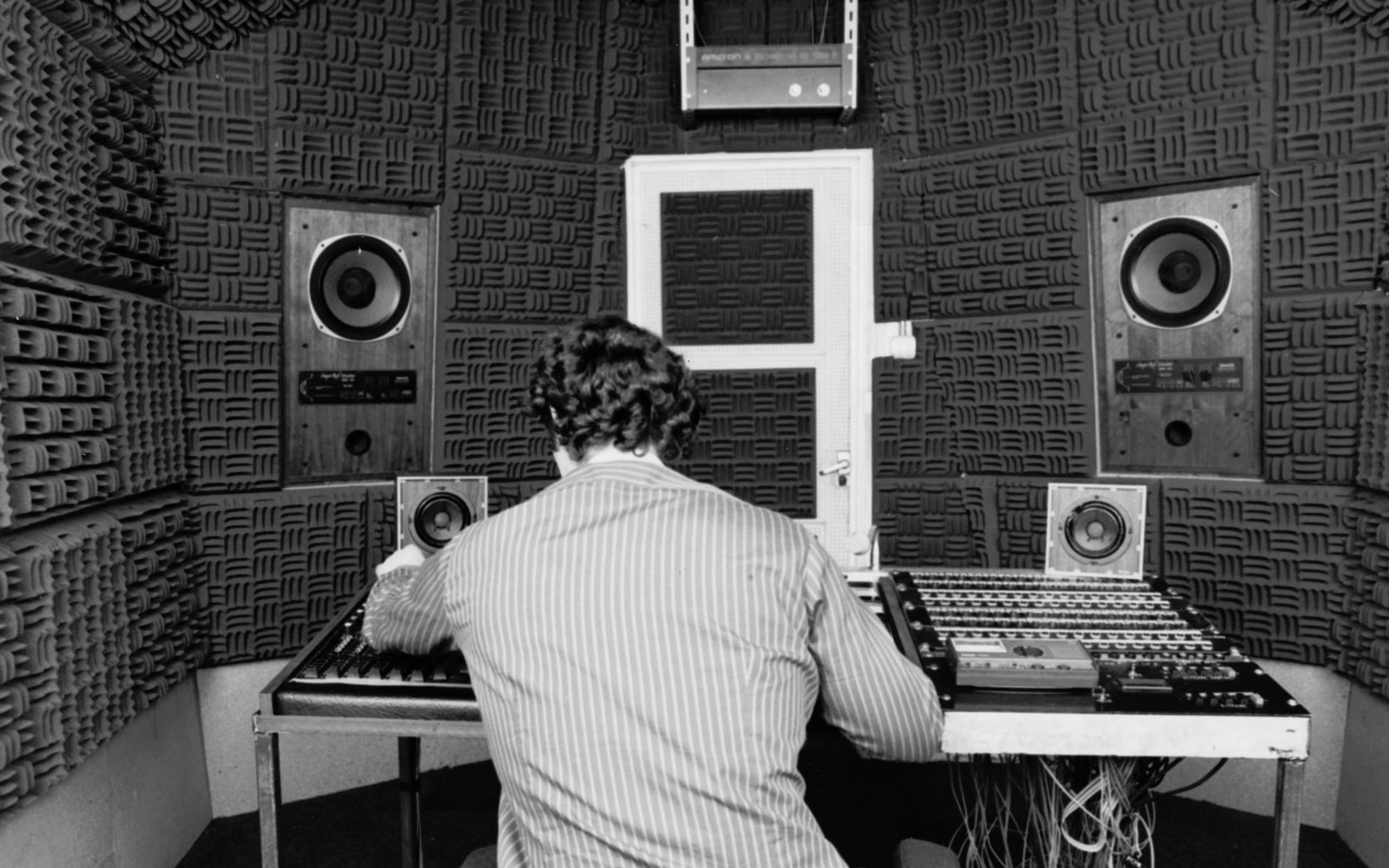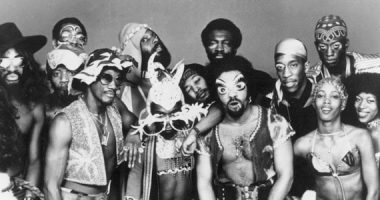
Salford College of Technology recording studio in the Adelphi Building, Manchester 1984 | University of Salford | CC BY-NC-ND
Born in 2011, Vaporwave combines previous electronic styles with advertising and corporative sounds from the eighties and nineties. In spite of the diversity and ambiguities in its attitude and message, vaporwave can be considered a critique and a parody of consumer society, even though aesthetically it displays a curious and nostalgic fascination with its artefacts. Not long after being hailed as the latest internet-based music microgenre, vaporwave was given up for dead. The short-lived phenomenon gave rise to all kinds of opinions and questions: had it become a music meme? was it really dead? what precisely is or was vaporwave anyway? and what were or are its links to anti-capitalist critique?
The history of vaporwave has gone hand in hand with controversy over its birth, death and resurrection, and with debate around its ideological ambiguity regarding the techno-capitalist model of progress. The sounds and imagery of vaporwave invoke a kitsch, ultra-colourful, hyper-technological world full of LCD screens and all kinds of digital gadgets.The psychedelic, seemingly arbitrary iconography of vaporwave also includes classical sculpture, palm trees, titles written in Japanese characters and graphic references to obsolete computing systems and video games. These elements make it a somewhat strange and disconcerting genre with an undefined aesthetic, and put it in a historical space of its own.
The exclusively internet-based vaporwave universe looks back with benevolent irony at a time when advances in consumer technologies and communications promised a brilliant future, brimming with possibilities. Before the advent of social media and smartphones, before we had lost our innocence regarding the blessings and potential of hyperconnectivity and algorithmic intelligence, the internet looked like a window opening out onto a cybernetic garden of Eden that was prosperous, democratic, and humanistic. For users at that time, the closest thing to millenarian fears related to the net was a droll fascination with the arrival of the “millennium bug”. They were the years of fin-de-siècle vertigo and of naive excitement at the imminent change of millennium, which vaporwave invoked almost a quarter of a century later.
But were did vaporwave come from? The term was coined in 2011 to describe a microgenre that had started circulating on the internet. James Ferraro (alias Bebetune$), Chuck Person (alias Daniel Lopatin / Oneohtrix Point Never) and Macintosh Plus (alias Ramona Andra Xavier / Vektroid / New Dreams Ltd / PrismCorp Virtual Enterprises) were among the originators of this genre that ceased to be “micro” and branched off into myriad projects, sub-categories and niche record labels. The name itself reflects an old-fashioned, innocent view of the future: it is a variation on “vaporware”, the term used to refer to technological products that are advertised for release, along with photographs or infographics, but never actually make it to the production stage or onto the market. Vaporware products are an unfulfilled technological promise, an obsolete futurist dream forever anchored in the past.
Preceded (and to some extent influenced by) phenomena like hypnagogic pop, witch house and seapunk, vaporwave often takes fragments of commercial or advertising music from the eighties and nineties and slows them down to half their original speed. Rhythms, synth lines and other elements like corporate jingles and sounds from operating systems and software programmes are then layered over those slowed-down loops. Smooth jazz, soft rock, new age, muzak, and anything else likely to be played in an elevator, a waiting room, or while waiting for a phone company to answer your call, are some of the sources that vaporwave artists use to create their plunderphonic compositions. Vaporwave is the quintessential music of the non-place, the on-hold melody of the call centre for an imaginary (retro)futurist holiday destination in some unspecified part of the planet. The question that vaporwave provocatively seems to ask is: would we or would we not like to call that call-centre and make a reservation? In other words, does the world it represents seduce or horrify us?
In an article entitled “Vaporwave and the Pop-Art of the Virtual Plaza”, Adam Harper, one of the first exponents of vaporwave, explores whether it is more utopian or dystopian, and whether it criticises capitalism or surrenders to it. In Harper’s opinion, this ambiguity is at the very heart of vaporwave, and it is precisely what makes it an interesting phenomenon worth thinking about. He also suggests that vaporwave could be understood as the soundtrack to accelerationsim, a philosophical idea which is spoused by theorists like Nick Land, and which inspired Alex Williams and Nick Srnicek to write the “Manifesto for an Accelerationist Politics”.
Dissatisfaction with the present, nostalgia for “lost possible futures”, and a yearning for an “alternative modernity” that is in some sense similar to certain science fiction scenarios are some of the points that Williams and Srnicek mention in their manifesto, and they also seem to be among the ideas that inspire vaporwave artists. In Retromania. Populture’s Addiction to its Own Past, Simon Reynolds quotes Daniel Lopatin (aka Chuck Person) explaining that the decelerated versions of eighties pop songs on his Ecco Jams album are the result of his experimentation with “slow modes of listening in an otherwise fucked-up/hypersped society”. Lopatin also talks of “the seduction of the loop, and the meditative promise of it, how it hints at infinity.” More provocative and closer to accelerationist ideas, James Ferrano says that his album Far Side Virtual (Wire magazine’s 2011 album of the year) and his project 100% (presented at MoMA PS1 in 2014) are intended to evoke the “aestheticization of capitalism”. He also admits that he is obsessed with capturing what he calls a ‘pan global generic sound’ or ‘global ambiguity’.
In Ghosts of My Life. Writings on Depression, Hauntology and Lost Futures, cultural theorist Mark Fisher, who died earlier this year, explores the relationship between the “slow cancellation of the future” (an expression he borrows from Franco “Bifo” Berardi) and our culture’s inability to articulate an idea of the present. Futurist music, for example no longer suggests a future from which we can expect anything new, Fisher says, so any attempt to represent the future appears doomed to remain nothing more than retro-futurist speculation. Returning to the words of Frederic Jameson, Fisher warns that contemporary culture is in a “nostalgic mode” that keeps it in a state of “formal attachment to the techniques and formulas of the past.”
In view of this, Fisher suggests using the neologism “hauntology” (hantologie) – which was coined by Jacques Derrida in his book Spectres of Marx – to, among other things, describe a certain type of electronic music that emerged just over a decade ago. Derrida describes hauntology as the mode in which everything that exists does so based on a series of absences that precede and envelop it, and at the same time make it coherent and intelligible. In reference to hauntological music, Fisher writes that “the hopes created by postwar electronica or by euphoric dance music of the 1990s have evaporated – not only has the future not arrived, it no longer seems possible.” But at the same time, “the music constitutes a refusal to give up on the desire for the future.” Thus hauntological music appears to swing between nostalgia and aspirations for a lost future, simultaneously projecting itself forwards and backwards in time. Even though Fisher does not mention vaporwave (the genre as such did not exist yet), his description of hauntological music seems to match the genre’s particular (retro)futuristic aesthetic and ambiguous historical stance.
In his book Babbling Corpse. Vaporwave and the Commodification of Ghosts, Grafton Tanner describes vaporwave as a reaction to today’s cultural regression and a subversive electronic eulogy to “techno-decay during the twilight of late capitalism.” Even so, Tanner knows that it is dangerous and difficult to try to define vaporwave. At the mercy of internet trolling and of the implacable semio-economy of memes, vapowave is a volatile expression that resists interpretation and can also be transformed by it. Or even die as a result. In 2012, when Adam Harper published his article and Anthony Fantano posted his video-review of the the Macintosh Plus album Floral Shoppe on his YouTube channel, many fans believed that exposing vaporwave beyond the small circles that it belonged to had killed off the genre.
The image on the cover of Floral Shoppe, and the second track on the album, “リサフランク420 / 現代のコンピュー” (the closest thing to a vaporwave anthem), inspired an avalanche of memes and videos making fun of their impenetrable aesthetic and meaning. Ironically, it was probably these memes that introduced vaporwave to many neophytes who gradually discovered the genre and started to take it seriously. In the last few years, the death of vaporwave as a result of various causes has been announced repeatedly. But in spite of this, and in spite of the existence of things like a label exclusively dedicated to vaporwave parodies and outlandish offshoots like simpsonwave, there is still a steady increase in the number of followers and the genre continues to generate discussion (see for example the active vaporwave forum on Reddit). As Scott Beauchamp suggests in his article “Vaporwave is dead. Long live vaporwave”, the genre may have been given up for dead because it does not fit the usual mould of a music commodity or product. Vaporwave has always circulated outside of the margins of the music business and its usual channels, so it has always been phantasmagorical in a sense: a musical hauntology trapped between the past and the future, safe from fads and the market logic in the internet’s hidden non-places.




Laura | 13 September 2017
Un article sobre Vaporwave en Castellà i amb info currada. Gràcies!
Laura | 13 September 2017
Un article sobre Vaporwave amb informacio contrastada, genial!
Administrador | 13 September 2017
Gràcies!
Leave a comment